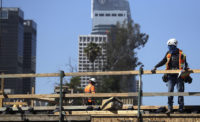Study: Housing Costs Squeeze California’s Labor Supply
California housing’s high cost has forced more construction workers to endure longer commutes for affordability, squeezing project staffing and worsening an already tight labor market, says a new study.
Construction has “a worker problem, and this may be part of the reason why,” economist and study author John Husing told ENR. His recent report for a state homebuilders group analyzes union and nonunion worker compensation and low and median home prices, focusing on southern California’s coastal markets and nine San Francisco Bay Area counties, and their respective adjacent inland regions. The report cites state figures of 80,000 homes built each year, a fraction of the estimated need for 180,000 annual units—attributing the gap to “the residential market’s reaction to state laws and policies.” Husing says only 18% to 23% of households can afford a median-priced home in high-cost areas, pushing workers to seek affordability in the “outlying” Inland Empire and Central Valley regions.
The report cites longer worker commute times—up to five hours, 20 minutes from Modesto to Palo Alto round-trip— that it says has increased employee expenses and lowered disposable income, which may cause workers to opt out of construction for jobs closer to home and could impact urban economics by slowing down projects. Associated General Contractors of California CEO Peter Tateishi says many of its firms try to offset commute impacts with temporary near-site housing, but contractors have limited options in offering flexible work hours due to state rules and owner restrictions.
Michele Daugherty, Associated Builders and Contractors CEO in Northern California, says competition for skilled workers between major commercial and municipal projects and residential developers is pushing up wages but also hiking building and housing costs and forcing many Bay Area developers to seek labor from outside the region. She suggests tieing housing to commercial and transportation development and more affordable and large, multifamily housing.




